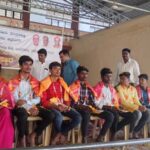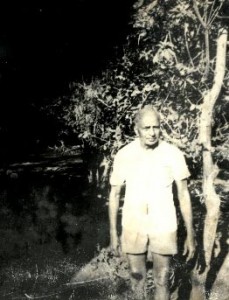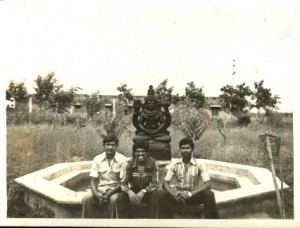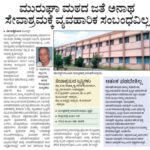ಸುದ್ದಿಗಳು
ಜಾತ್ಯಾತೀತ ತತ್ವದಿಂದ ದೇಶ ಸುಭದ್ರ – ಪ್ರೊ.ಕೆ.ಈ.ರಾಧಾಕೃಷ್ಣ

ಮಲ್ಲಾಡಿಹಳ್ಳಿ 10-08-2022: ವಿದ್ಯಾರ್ಥಿ ಜೀವನದಿಂದಲೇ ಜಾತ್ಯಾತೀತ ತತ್ವವನ್ನು ಪಾಲಿಸಿದಾಗ
ವಿದ್ಯಾರ್ಥಿಗಳಿಗೆ ಏಕಾಗ್ರತೆ ಅತ್ಯವಶ್ಯ-ಬ್ರಹ್ಮನಿಷ್ಠಾನಂದ ಸ್ವಾಮೀಜಿ

ವಿದ್ಯಾರ್ಥಿಗಳು ವಿದ್ಯಾಭ್ಯಾಸದ ಹಂತದಲ್ಲಿ ಏಕಾಗ್ರತೆ ಅತ್ಯವಶ್ಯ ಎಂದು ಚಿತ್ರದುರ್ಗ

Follow Us
Fond Memories of ‘Malladihalli Swamiji’
ಸೋಮವಾರ, ಆಗಸ್ತು 31st, 2009Life is a journey from the ‘womb to the tomb’ they say and in this journey we pass only once and that too one way. I have tried to make the most of life, in every step of its journey. Some missions did not even take off; many others took off, but crashed; a few have been a disaster and those I did manage to complete have given me immense satisfaction. This ‘piece of writing’ is about one such project in life, though completed … still struggled to keep going…
In October 1984, with the blessings of my parents, I set off to the then obscure village called Malladihalli in the taluk of Holalkere in Chitradurga District, approximately 300 kms north-east of Mangalore with a purpose – a purpose to learn the grand old Indian art of Yoga. By then, I had read and heard a lot about its benefits and now the time had come to experience it first hand by putting knowledge into practice.

Malladihalli Raghavendra Swamiji (1890-1996) in the Ashram’s premises in October 1984 at the ripe age of 94
In this sleepy hamlet Malladihalli, resided a renowned person called Shri Raghavendra Swamiji, more popularly known as ‘Malladihalli Swamiji.’ My image of a Swami had always been that of a holy man, with long saffron robes as his attire, with thick beads hanging around his neck and a white long dwindling beard as his trademark, along with three-white-lines on his fore-head and seated in a meditational pose with his hands occupied. I had thought the more holy ones had their habitat in the jungle and would come out once in a way to do the pooja in the temple … no matter wherever he went, at the end of it, he would return to the jungle to meditate.
This thinking was embedded by the epics of Mahabharata and Ramayana that I had to study indepth in preparation for the exams conducted by the Dakshin Bharath Hindi Prachar Sabha. In preparation for all their exams I had sat for – from ‘Prathama to Dvitheeya,’ from ‘Madhyama to Visharadha’ and finally ‘Rashtrabasha’ … took me on a journey of learning the epics in almost its entirety from the allotted text books. The Rishi-munis in the Bollywood movies of my time who spoke only the truth unlike other sages who might falter, added to the flavour … So, as my destination neared, I was more nervous than excited …. Will I be able to cope? Or will I be running away the very first day? These negative thoughts suddenly began to crop in my mind.
It was about half-past-two in the afternoon on the 3rd of October 1984, when the conductor of the KSRTC bus gave a shrill which pierced our ears, saying all those who were going to the Ashram should get down ‘at this stop.’ I thought I was the only one to tread, but was surprised when three-quarters of the bus emptied itself. That gave me the first signs of courage…
We hardly had walked about 300 metres towards our left side of the road itself when my gaze fell on the entrance to the Ashram with Kannada alphabets ‘Anatha Sevashrama Trust Regd.’ on a huge semi-circle board above the massive gate. Where is the jungle I have been thinking about all this while, I pondered to myself as I made my way inside the premises. A little away I spotted the Registration Desk. I had to produce the receipt at the desk as a proof that I had enrolled for the 29th Yoga Camp which I promptly did. I was put in a Group and accompanied to the place of accommodation by one of the assistants that was a bit away at the pre-university College. The programme for the rest of the day was to relax, have tea, an introduction with the Swamiji in the evening and dinner.
I met many of my room-mates and felt very relaxed in my group and being fluent in different variations of Kannada made the difference as well. We had our evening tea … the time had finally come to meet Swamiji. An Instructor was assigned to us who told us to assemble in a room awaiting Swamiji’s arrival.
Face to Face with Swamiji:
I did not anticipate his arrival would be marked with thunder and lightning but at least expected it would be preceded with some agarbatti fragrance coupled with some chiming of bells … and all of a sudden even before my mind could comprehend, a clean shaved person with a slight bent entered the room wearing small grey shorts (shorter than the ones I was used to) and a white sandow banyan. As I wondered why everyone stood in reverence, the next thing I could recollect was I was still standing on my legs and had not fainted. Where is the holy man with the long saffron robes I was looking for? And where is his trademark beard? So many questions unanswered – I shook my head to face the reality …. Here stood the Swamiji of modern era, 94 years of age …
He first gave a short introduction of himself and the purpose we were all here, then moved to take our introductions. He was quite amused to know that I was from Mangalore and before I could realize he greeted me with a few words in Konkani and added that he knew Tulu too. That was another shock … I think I pinched myself to make sure that I was not in Mangalore!
In the initial days when the Camp commenced, my first name went for a toss. Right from Swamiji, his assistants and the participants – they all spelt it the wrong way. Instead of pronouncing the ‘ph’ as ‘v,’ the single name was split into ‘step’ ‘hen’ – obviously someone while translating into Kannada divided my Greek name into two and that became official with everyone, everywhere. My surname took a pounding too. It was such an alien surname in that part of the world… I could not simply let that go and had to force myself to introduce my second surname ‘Prabhu’ to keep myself at ease and all others too … and so to my name and surname which already existed in the records, my second surname was added and thus called and that easily blended in no time.
The Camp Schedule:
Each day had its scheduled time-table that was followed to precision. With around 200 people attending the Camp, it was never an easy task to go about that way. Our day started at 5 a.m. with yogic exercises and those Swamiji’s words still echo in my ears when he began – “You have to sit cross-legged … shoulders straight. Now close your eyes. Just relax with your whole body in this position. As you keep your eyes closed, observe your breath. Inhale, exhale … Inhale, exhale… Inhale, exhale … ” This was followed by Suryanamaskara (Sun Salutation) and other Yogasanas until 6.30 a.m. after which breakfast was served. We had breakfast, lunch, evening tea and dinner in a big area called ‘mogasale’ (outhouse) with banana leaves and a combination of vegetarian dishes. Food was never a problem, in fact enjoyed a lot, my mom being more of a vegetarian … the hitch was sitting cross-legged on the floor and eating with my hands that I was not used to at all… that was the biggest difficulty I faced and naturally I was the first one to get up supposedly finishing my meal unable to bear the pain after a point of time sitting that way. All along in my upbringing, it was dining tables and spoons!
Steel Body:
The matter became worse in the process of learning the different Yogasanas. Especially the Padmasana (the lotus position) and the rest belonging to the same family that requires cross-legged sitting posture became a virtual nightmare. The more I tried, the more I became the laughing stock falling sidewards or backwards … getting dubbed as a person with a ‘steel body.’ The Assistants gently enquired: Your body seldom seems to bend. Did you go for any heavy exercises before? To cover myself, proudly I had answered – For five years; I was in karate and judo! Thankfully, this put the curtains down and they realised that might have made my body stiff and a sense of understanding caved in. Hearing my predicament, at one point Swamiji had also stepped in advising me to take it easy and not to stress too much as there were other Asanas which more or less covered the ones that I was having difficulty with. I was the youngest in the Camp and Swamiji was the Oldest – there appeared to be some sort of a bond.

The statue of Lord Shiva performing yogic meditation in the Padmasana posture. Far behind, a glimpse of the place where we were put at.
Two Hours with Swamiji:
In the programme ‘Swamijiyavarodane Eradu Ghante’, each group had two hours with Swamiji. It was all about Swamiji as a guide leading us to different buildings to explain the significance and we asking questions in the process. I learnt it was a new addition for our batch – the 29th Camp of which I was a part of and later heard was discontinued. From the assembly point, Swami first led us to his unique place where he used to do his Dhyanam and also to his place of residence in the large premises. He walked so briskly, many of us had to run to catch up with him. I consider myself a brisk walker, but where was I? The last one among all! After a walk of nearly a kilometre and a half, Swamiji stopped for everyone to catch up with him – led us somewhere underground to a cellar place so to say and explained to us that this was his ‘Sadhana’ and every day after waking up early would come here to start his daily routine … how early, we asked? … At 3 a.m., he replied. He explained four hours of sleep was more than enough for him. He answered comfortably all our questions pertaining to Yoga and the related topics but when it came to personal queries, he ducked almost all of them. He showed us all around giving a good introduction from his days when he arrived at this place in 1943 until now of how things in general have turned to be. As regards his personal history, the only things we could extract from him were he was born in Kerala in 1890 and that his original name was Kumaraswamy.
Later I learnt, his personal side of life was not known to anyone, not even to his close associates. However, due to intense pressure of his devotees, he did write his autobiography “Jolige Pawada” in 1993, in which he has documented his life history from memory of the last over hundred years.
Within the premises if I could recall, among other things had a well equipped gymnasium, a library housing books on yoga and ayurveda, a well paved playground, an Ayurveda Hospital with modern equipment and amenities and a pharmacy attached to the College of Ayurveda. In the Hospital yoga treatment was integrated with ayurveda treatment. At the other end was the Vishwa Yoga Mandir – an auditorium with a seating capacity for 500 people that housed many statues depicting different yoga postures. The Auditorium was designed for the purpose of organizing Yoga Camps and Seminars. At the end of our Camp, we had our practical exams in the Auditorium that echoed Swamiji’s instructions. To add, the Centre ran an Orphanage, many Schools and Colleges and a Teachers’ Training College.
During our spare time, we took a round of the village. The village was always buzzling with simple living. People had a smile on their faces as they went about their day to day chores. The barking of the dogs, mowing of the cows, chirping of the birds, the tang of the cow-dung, the beautiful rangolis in the front yard, the cool breeze, two wheelers zooming through the muddy roads leaving a trail behind, the unique smell of the grocery shops, the call for prayer in the local mosque at the far end of the village – all added to the natural beauty. At the end of it all, we used to savour tea prepared in a makeshift hut that was served in a mud cup which lingered long after we returned to the Ashram.
The activities we had during the last few days in the Camp turned out to be lasting memories. There were entertainment programmes, special meals … the list was quite long. We developed an attachment that we belonged to this place. No-one wanted to leave. On the penultimate day, we had an exam too – 50 for practical and 100 for theory. The best bet for me to be on top was to score well in theory that was in Kannada. I prepared myself by refraining from visiting the nearby historical places with the group like Chitradurga Stone Fort (Kallina Kote), Fort of Seven Rounds (Elu Sutthina Kote), Obavvana Kindi (the crack hole in the rocks), Tanneeru Doni – a small water source which holds cold water all round the year and the rest. The result was an overall percentage of 83% with an ‘A’ Grade that was bettered by a few. I had indeed accomplished my mission!
http://www.daijiworld.com/chan/exclusive_arch.asp?ex_id=1148














